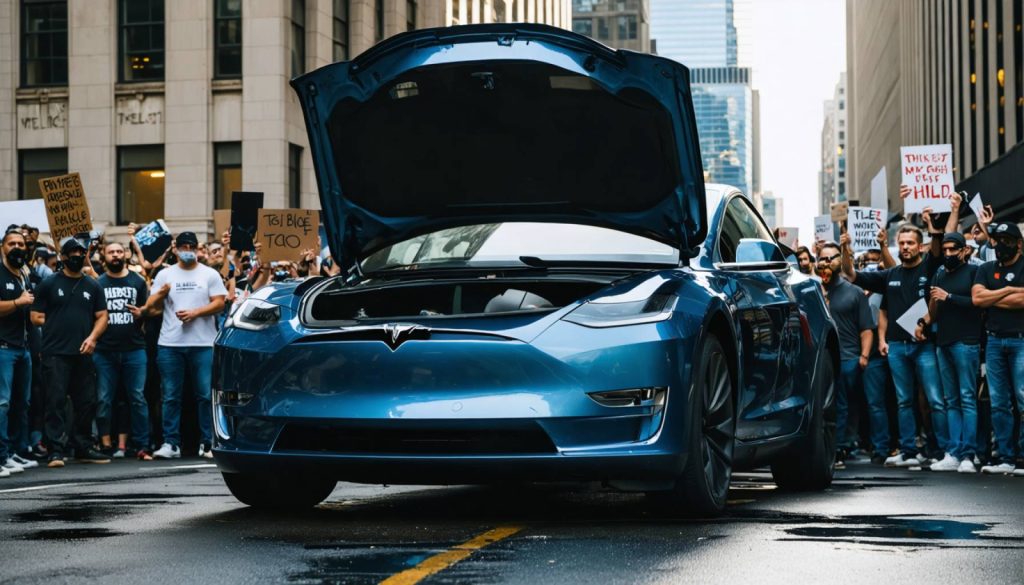
- The “Tesla Takedown” movement is globally challenging Elon Musk’s influence by targeting his financial interests.
- Protesters employ nonviolent methods, encouraging divestment from Tesla and avoiding Tesla purchases to weaken Musk’s economic power.
- Musk’s wealth, heavily tied to Tesla’s $829 billion valuation, allows him considerable political sway, exemplified by significant acquisitions and political donations.
- Authorities conflate peaceful protests with vandalism, threatening participants with “domestic terrorism” labels, thereby setting a dangerous precedent for civil liberties.
- The FBI’s surveillance on protesters under terrorism suspicion risks infringing on privacy and freedoms without solid evidence.
- The government historically uses rhetoric to delegitimize protests, framing them as radical to undermine their legitimacy.
- Tesla Takedown organizers urge adherence to safety protocols, highlighting the importance of safeguarding dissent as a democratic right.
The peaceful zeal of the “Tesla Takedown” movement is rapidly echoing across the globe, rallying thousands to converge on Tesla’s urban sanctuaries—from showrooms to charging stations. Behind this widespread clamor lies a powerful declaration: challenge Elon Musk’s influence on government policy and hit him where it hurts—his financial empire.
The grassroots organizers, armed with conviction rather than cocktails, stress nonviolence, aiming to undermine the financial underpinnings of Musk’s empire. Their strategy? Persuade people to divest from Tesla stock, abstain from purchasing new Teslas, and sell their existing cars. In the end, they seek to shrink Musk’s economic reach, which directly props much of his philanthropic and political endeavors.
Consider Musk’s ventures: intrinsic to his wealth, Tesla propels him to unprecedented financial heights. His holdings in Tesla, roughly 13% of a colossal $829 billion company valuation, cement his stature as the world’s richest man. This affluence empowers Musk to influence political outcomes substantially—take, for example, the $44 billion acquisition of Twitter and over $260 million siphoned into political action committees that back favored candidates.
But as the protests grow, so does the opposition. A hazy conflation of protesters with acts of vandalism by fringe elements lets powerful figures distort the narrative. President Trump’s administration paints the disruption with broad, ominous strokes, waving the threat of “domestic terrorism” and promising severe reprisals against both peaceful and violent actors alike. This nebulous characterization poses a dangerous precedent for those exercising their First Amendment rights.
Authorities have the leeway to surveil these gatherings under the guise of terrorism suspicion, encroaching upon civil liberties—the FBI doesn’t require concrete evidence before initiating surveillance, stretching the bounds of privacy by photographing, infiltrating gatherings, and accessing private records. Superficially dismissed as merely bureaucratic action, such measures could have chilling effects, dissuading legitimate protest through fear of wrongful criminal labeling.
Historically, conflating peaceful dissent with insurrection is a well-worn tactic of undermining movements. Government rhetoric often aims to delegitimize these waves of popular dissent by casting them as radical and criminally orchestrated.
Amidst the escalating tension, the message from Tesla Takedown organizers remains resolute: prioritize your safety, follow protest regulations, and prepare for legal defenses if necessary. Despite efforts to paint their activity in a criminal light, the protests—firm in their commitment to nonviolence—assert a vital reminder: in democracies, safeguarding the right to dissent is not just an option but an obligation. As long as their voices echo globally, the movement continues to spotlight this indispensable freedom, demanding accountability from figures like Musk, whose unchecked influence looms heavily over economic and political landscapes.
The Tesla Takedown Movement: A Global Pushback Against Musk’s Influence
Background on the Tesla Takedown Movement
The Tesla Takedown movement represents a growing wave of global grassroots activism challenging Elon Musk’s influence on government policy. This nonviolent collective aims to hit him financially by persuading the public to divest from Tesla stocks and avoid purchasing Tesla products. Musk’s significant holdings in Tesla, valued at approximately 13% of an $829 billion company, fuel both his financial power and political sway.
More Than a Protest: The Economic Impact
Tesla’s business ventures are crucial to Musk’s financial empire. By focusing on Tesla, the movement hopes to curtail Musk’s ability to influence through his wealth. For instance, Musk’s $44 billion acquisition of Twitter and significant contributions to political action committees underscore his substantial influence.
Controversies and Civil Liberties Concerns
The movement faces notable opposition from entities that conflate peaceful protests with criminal activities. This manufactured controversy allows government bodies, such as the FBI, to surveil activists under suspicions akin to “domestic terrorism.” Such practices pose substantial threats to civil liberties, potentially discouraging participation due to fear of unwarranted criminalization. Historically, this tactic of labeling dissent as radical is a means to delegitimize protest movements, undermining democratic principles.
Key Questions and Insights
1. Why target Tesla specifically?
Since Tesla is a primary source of Musk’s wealth, reducing its stock value or sales directly impacts his economic influence. Thus, targeting Tesla strikes at the hub of Musk’s financial power.
2. What are the potential risks for protesters?
The conflation of protests with criminal acts can lead to increased surveillance and legal repercussions for participants. Staying informed about legal rights and protest laws is crucial.
3. What is the government’s stance on the movement?
There is an ongoing debate about the portrayal of protests as a national security threat, which justifies increased surveillance and law enforcement presence, raising concerns about the erosion of civil liberties.
Real-World Use Cases
– Financial Strategy: Investors considering Tesla stocks should follow the movement’s impact on Tesla’s market performance and its potential influence on the company’s valuation and public perception.
– Legal Preparedness: Activists should learn about protest regulations and potential legal defenses by consulting with legal experts to safeguard their rights.
Market Trends and Predictions
– Impact on Tesla’s Market Value: Continuous protests may spark a domino effect on investor sentiment, leading to market fluctuations.
– Industry Shift: Growing ecological and ethical concerns can accelerate the shift towards alternative electric vehicle manufacturers preferred by environmentally conscious consumers.
Actionable Recommendations
– Diversifying Investment: To mitigate risks, investors could explore a diversified portfolio encompassing a broader range of sustainable technology firms.
– Increased Awareness: Amplifying awareness about the movement’s objectives can help to dispel negative portrayals and solidify community support.
For additional context and to stay informed on industry developments, you might consider looking at sources like the Tesla website, which offers insights into the company’s latest initiatives and challenges.
In conclusion, while the Tesla Takedown movement pursues its peaceful agenda, understanding its complexities, potential impacts, and the broader implications on civil liberties remains crucial for both activists and the general public.



